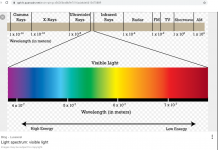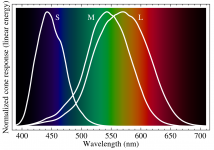You can even make pictures without a lens.
I made this picture with just a body cap on the camera with a tiny hole in the middle instead of a lens. A camera obscura so to say.
I could have sharpened the image considerably, had I taken more than just one picture.
Is there an electromechanical analogy to a pinhole camera? Pinhole size cannot be reduced indefinitely because limited by diffraction, so nothing is in focus. But everything is equally out of focus, unlike lenses.
All good fortune,
Chris
Yes, that's true. We use this technique on a regular basis when shooting commercial products with my better half. (She's the boss 😉 )Shooting multiple times the same scene adjusting one parameter only (say focus point) and then stacking all images in SW is used widely.
Here's the focus stacking taken to the extreme:
Microsculpture - The Insect Portraits of Levon Biss
Is there an electromechanical analogy to a pinhole camera? Pinhole size cannot be reduced indefinitely because limited by diffraction, so nothing is in focus. But everything is equally out of focus, unlike lenses.
I was ready to answer that the limit is close to 10X longest wavelength component but I am not sure anymore 😀
On the Diffraction Limit for Lensless Imaging
10micron stepsHere's the focus stacking taken to the extreme:
Microsculpture - The Insect Portraits of Levon Biss
"Most of my file (*) images are made of between eight thousands and ten thousands images"
(*) Micro-Sculpture Project (25 pictures)
😱
George
Attachments
Beautiful stuff. My better half has a still camera that stacks multiple rapid light value (product of time and aperture area and ISO) exposures internally. (Never been used.) The dragonfly pictures on Wikipedia are inspiring, but conventional single sphere of focus:
Dragonfly - Wikipedia
You must be beautiful to survive for hundreds of millions of years.
All good fortune,
Chris
ps: although I think it was Darwin who said that God must love beetles because he made so many of them.
Dragonfly - Wikipedia
You must be beautiful to survive for hundreds of millions of years.
All good fortune,
Chris
ps: although I think it was Darwin who said that God must love beetles because he made so many of them.
Last edited:
Thank you George. Isn't it interesting that we can hear ten octaves (when young) but only see one octave? Many flying creatures see into (our) ultra-violet. Some tortoises see in four colors. We live in a magical world and only directly perceive a tiny fraction of it. The rest we just make up "out of whole cloth."
Much thanks, as always,
Chris
Much thanks, as always,
Chris
There are a very few tetrachromic humans. Sadly none with IR or UV sensing. Cuttlefish and mantis shrimps have the really wacky vision.
Stunning pic Chris. I recall reading somewhere that about 400 MYA when the Earths oxygen levels where higher, they had 12” wingspans.
There are a very few tetrachromic humans. Sadly none with IR or UV sensing. Cuttlefish and mantis shrimps have the really wacky vision.
For IR to be a useful sense for hunting and avoiding danger, we’d have to run at about 20 degrees cooler. I think this is also why a lot of snakes hunt at night when they’re still mobile, but their body temp has dropped off a bit.
Thank you George. Isn't it interesting that we can hear ten octaves (when young) but only see one octave? Many flying creatures see into (our) ultra-violet. Some tortoises see in four colors. We live in a magical world and only directly perceive a tiny fraction of it. The rest we just make up "out of whole cloth."
Much thanks, as always,
Chris
True as it might be, over the ten octaves we have a resolution issue restricting the amount of frequencies we can hear to several thousands.
On the other hand, in the single octave we see, we can discriminate between millions of colours, women even more than men. 😀
Hans
It’s women again. Out of the kitchen this time.There are a very few tetrachromic humans.
In professional L3 Visual Inspection examinations, the correct answer was the red color is synthesized at the optical nerve by way of combining optical information from retina’s S, M, L cones.
Sadly none with IR or UV sensing.
S cones are capable of responding to UV but UV doesn’t pass through the eye's lens.
Cone Fundamentals
George
Attachments
True as it might be, over the ten octaves we have a resolution issue restricting the amount of frequencies we can hear to several thousands.
On the other hand, in the single octave we see, we can discriminate between millions of colours, women even more than men.
Ignoring (because I know nothing about it, so it can't possibly be important) processing power enough to generate a rectilinear world view from a fish-eye lens and millions of colors (which don't even exist outside of an animal's mind) what's so great about vision, anyway?
He said, staring at a glowing screen.
Much thanks, as always,
Chris
Is there an electromechanical analogy to a pinhole camera? Pinhole size cannot be reduced indefinitely because limited by diffraction, so nothing is in focus. But everything is equally out of focus, unlike lenses.
All good fortune,
Chris
When applying a Gaussian blur convolution to a picture, you get something that resembles a pinhole picture.
I know a German company that applies a deconvolution to SEM images thereby increasing the resolution. A Nobel price was granted for this.
I can imagine a convolution applied to an audio signal with the same effect as a Gaussian blur to a picture, making it more difficult to locate the position of an instrument.
So maybe a deconvolution could restore a bad recording to some degree.
Hans
Not a Hi-End’s fashion pricing.My system was around $800 I think. In included a calibrated microphone. It was a long time ago. I still use it as my prefered acoustic measurement tool.
Demian, were you involved in the design of the AudPod?
George
Yes, that's true. We use this technique on a regular basis when shooting commercial products with my better half. (She's the boss 😉 )
Here's the focus stacking taken to the extreme:
Microsculpture - The Insect Portraits of Levon Biss
Haha, well I support a couple projects that use PALM imaging techniques, where we're hitting ~20nm voxel sizes. That's taking reconstructions to a whole new level, which we're using for looking inside cells at internal structure and localizations of proteins. 😀
Photoactivated localization microscopy - Wikipedia
Last edited:
0
I can imagine a convolution applied to an audio signal with the same effect as a Gaussian blur to a picture, making it more difficult to locate the position of an instrument.
So maybe a deconvolution could restore a bad recording to some degree.
Hans
Gaussian blur is just a two dimensional low pass filter, for audio it would just be a one dimensional low pass filter. When you say "bad" recording the impairment would have to be described by a convolution in order to use this technique. The problem in both cases is the reduced SNR in the part that is lost, there are literally 100's of papers on dealing with this issue.
To add to the noise factor, no matter what you're trying to deconvolve, you need a clear idea what exactly that aberration (to use an optical term) is, i.e. its impulse function, or you'll quickly make the problem worse. So with a recording, what is intended as a correction could easily become a user-preferred effect.
Not that it changes things much, if you're happier with that bit of signal processing, you're happier with that bit of signal processing. 🙂
Not that it changes things much, if you're happier with that bit of signal processing, you're happier with that bit of signal processing. 🙂
Not a Hi-End’s fashion pricing.
Demian, were you involved in the design of the AudPod?
George
It was all Bill Waslo's (bwaslo) work, sort of a hobby gotten out of control. It came to an end when Borland stopped supporting the language he used to write the software. I may be the last serious user but I can do a lot with it that I have found no practical way to do otherwise.
Yes, I fully agree that you have to know the whole process in detail when you want to restore location accuracy of instruments. It will be very complex affecting fase, reverberation etc in both channels, so probably way beyond our horizon.Gaussian blur is just a two dimensional low pass filter, for audio it would just be a one dimensional low pass filter. When you say "bad" recording the impairment would have to be described by a convolution in order to use this technique. The problem in both cases is the reduced SNR in the part that is lost, there are literally 100's of papers on dealing with this issue.
Hans
Last edited:
To add to the noise factor, no matter what you're trying to deconvolve, you need a clear idea what exactly that aberration (to use an optical term) is, i.e. its impulse function, or you'll quickly make the problem worse. So with a recording, what is intended as a correction could easily become a user-preferred effect.
Not that it changes things much, if you're happier with that bit of signal processing, you're happier with that bit of signal processing. 🙂
In audio production/creation that is called using a tape recorder.
Cheers
Alan
- Home
- Member Areas
- The Lounge
- The Black Hole......

